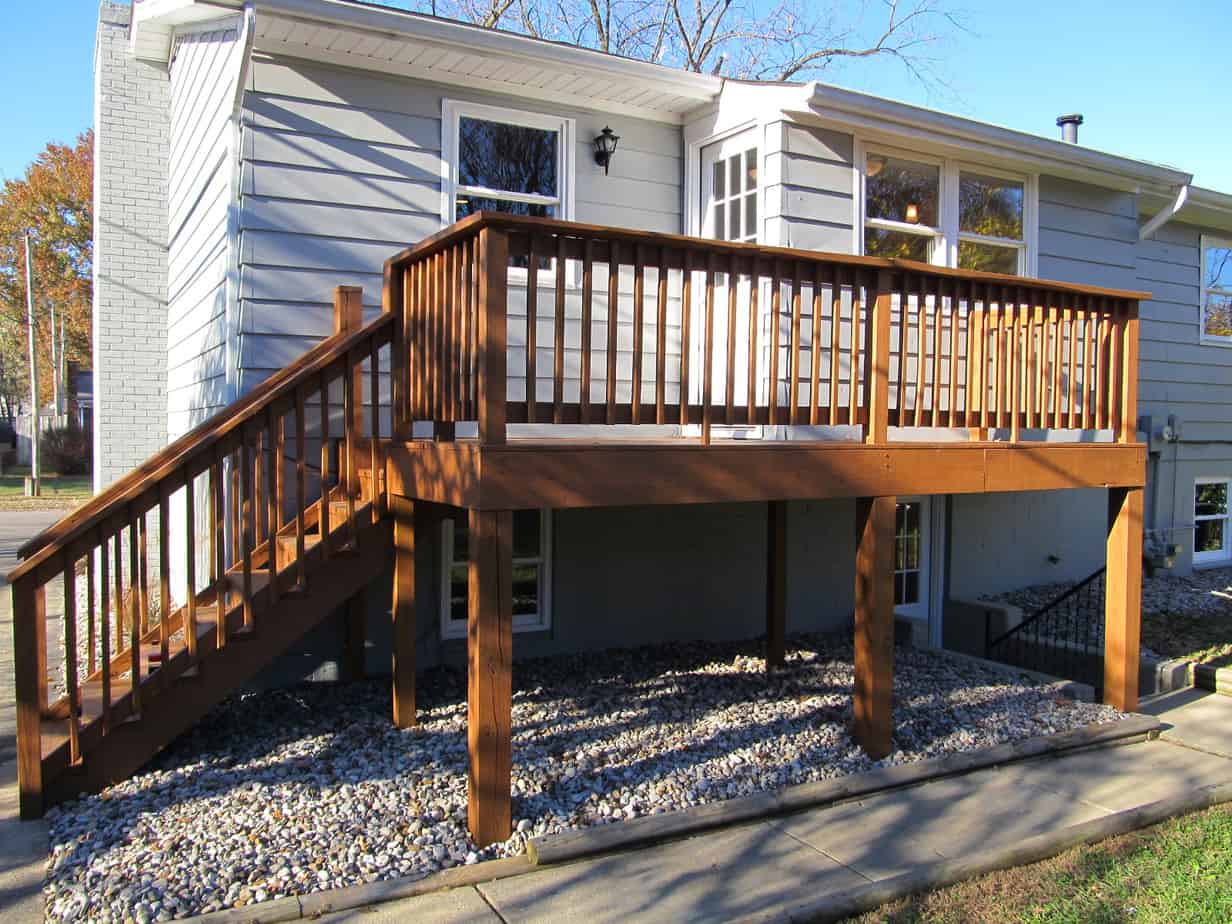Landscaping rock makes a great alternative to mulch, as it adds a lot of color and texture to landscaping and last for much longer.
As properly laid landscaping rock can last for years, while mulch needs to be constantly refreshed at least once a year to keep it looking its best.
However, one drawback of landscaping rock is that it can often be more expensive compared to mulch, which can be an issue if your landscaping on a budget.
So in this article, we’ve highlighted the seven cheapest rocks for landscaping, to help keep the costs down on your next landscape project.
1. River Rocks

Landscaping river rocks are one of the most popular landscaping rocks available, because of their cheap cost, widespread availability, and excellent color mixture, which allows the rock to blend seamlessly with numerous types of landscaping designs.
The rock is a type of washed stone that is typically harvested from river beds and creeks.
The smooth river rocks are known for their round edges and color diversity and are available in a variety of sizes.
However, the rocks are most commonly between 1 and 2 inches in diameter.
River Rock Cost
Depending on the size and color diversity of the rock, it will usually cost between $20 and $25 for a .4 to .5 cubic foot or 30 to 40-pound bag of river rock.
Pros
- Very Affordable
- Readily Available and Easy to Find
- Rocks Have Smooth Round Edges Making Them Ideal for High Foot Traffic Areas
- Best Color Mixture
Cons
- Larger Rock Sizes Allow Dirt and Debris to More Quickly Accumulate, Which Can Lead to Early Weed Growth
- More Challenging to Remove Due to Larger Rocks Sizes
2. Landscaping Gravel
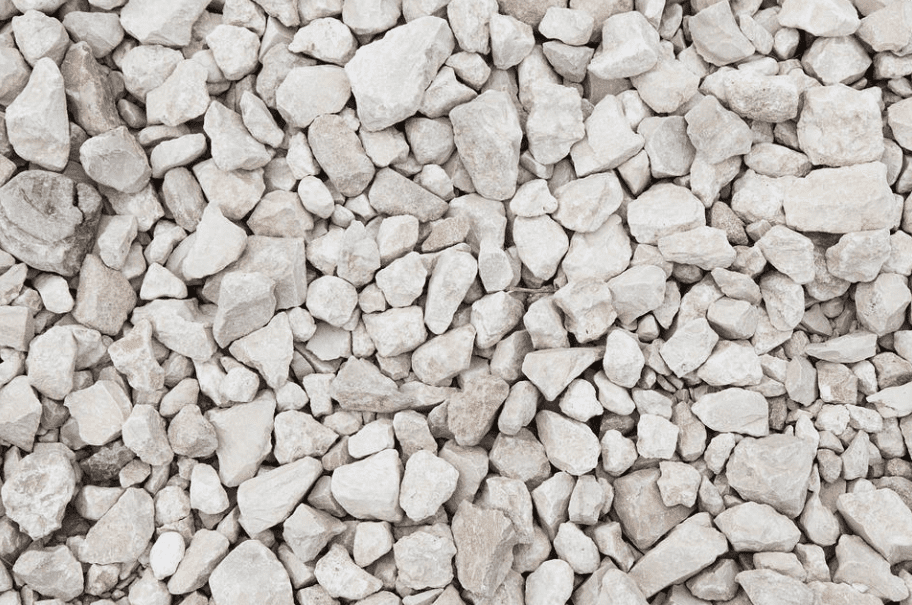
Landscaping gravel is one of the most popular choices for landscaping rocks because it’s affordable and easy to work with.
The gravel is available in a variety of colors including white, off-white, tan, black, gray, brown, and even pink.
The size of the gravel can vary, from small to large but it’s most commonly found in sizes that range from one to two inches across.
Landscaping Gravel Cost
Depending on the size and color of the landscaping gravel, it will usually cost between $28 and $35 for a .4 to .5 cubic foot or 30 to 40-pound bag of landscaping gravel.
Pros
- Affordable
- Readily Available and Easy to Find
- Available in a Wide Variety of Colors
- Easy to Work with
- Can Be Used in a Wide Variety of Applications
Cons
- Rocks Have Sharp Edges that are Painful to Step On
- More Basic Look Compared to Other Landscaping Rocks
3. Pea Gravel
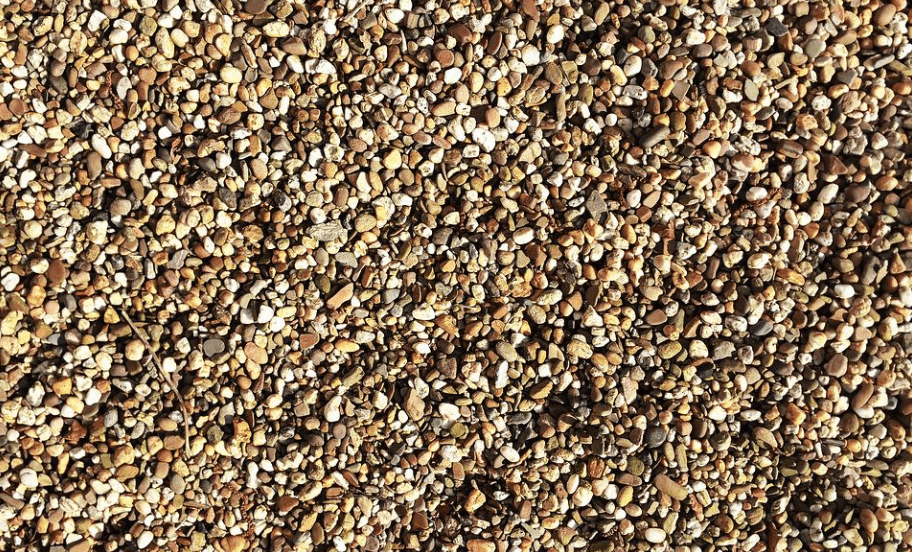
Pea gravel is a type of small, round landscaping rock that gets its name from its size, as they resemble the size of peas.
The rock typically ranges in size from .5 to 1.5 inches across and offers wide color diversity, offering a multi-colored mixture of earth tones like gray, tan, white, and black.
Most closely associated with river rock, pea gravel is just a smaller version of the rock.
Pea Gravel Cost
One of the most inexpensive landscaping rocks you can purchase is pea gravel, which usually costs between $4 and $5 per .4 to .5 cubic foot or 40 to 50-pound bag.
Pros
- One of the Cheapest Landscape Rocks Available
- Helps Maintain Soil Moisture and Prevents Erosion
- Rocks Have Smooth Round Edges Making Them Ideal for High Foot Traffic Areas
- Best Color Mixture
Cons
- Hard to Keep in Place Due to Smaller Rock Size
- Requires Some Type of Edging or Barrier to Keep in Place
- Easily Disturbed Which Can Leave Unsightly Dips in the Rock
- Needs to be Replenished More Often Compared to Larger Landscaping Rocks
4. Landscaping Pebbles
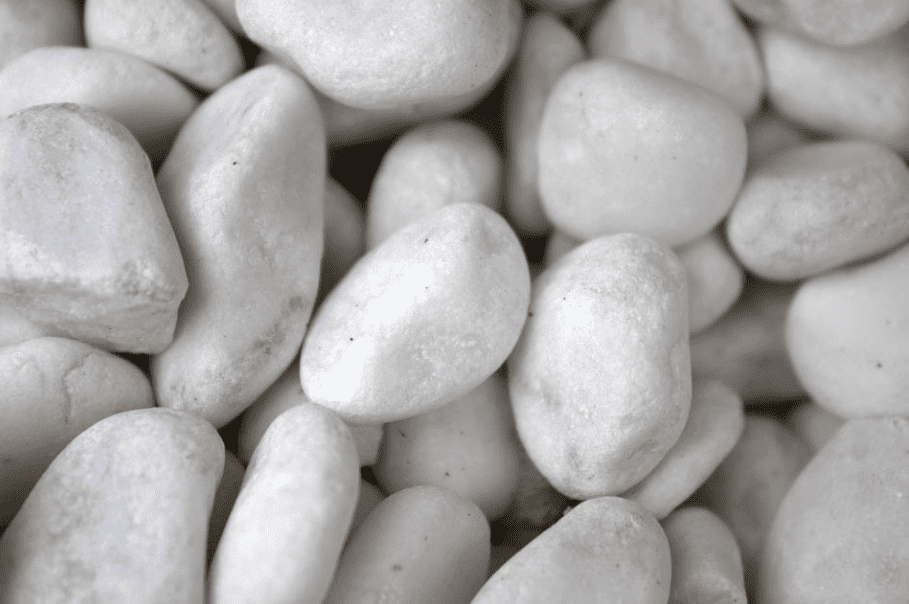
Landscaping pebbles are round rocks that resemble both pea gravel and river rock.
However, landscaping pebbles are generally much larger than pea gravel.
And they’re generally available in one particular color, whereas river rocks are frequently mixed with a variety of colors.
Landscaping pebble colors include everything from standard white, gray, and black, to more speciaity colors like red and green.
Landscaping Pebbles Cost
Pebbles are another affordable landscape rock that usually costs between $20 and $30 for a .4 to .5 cubic foot or 30 to 40-pound bag.
Pros
- More Uniform Look
- Available in a Wide Variety of Colors
- Better Suited for Modern Landscape Designs
- Rocks Have Smooth Round Edges Making Them Ideal for High Foot Traffic Areas
Cons
- Larger Rock Sizes Allow Dirt and Debris to More Quickly Accumulate, Which Can Lead to Early Weed Growth
- More Challenging to Remove Due to Larger Rock Sizes
5. Crushed Stone
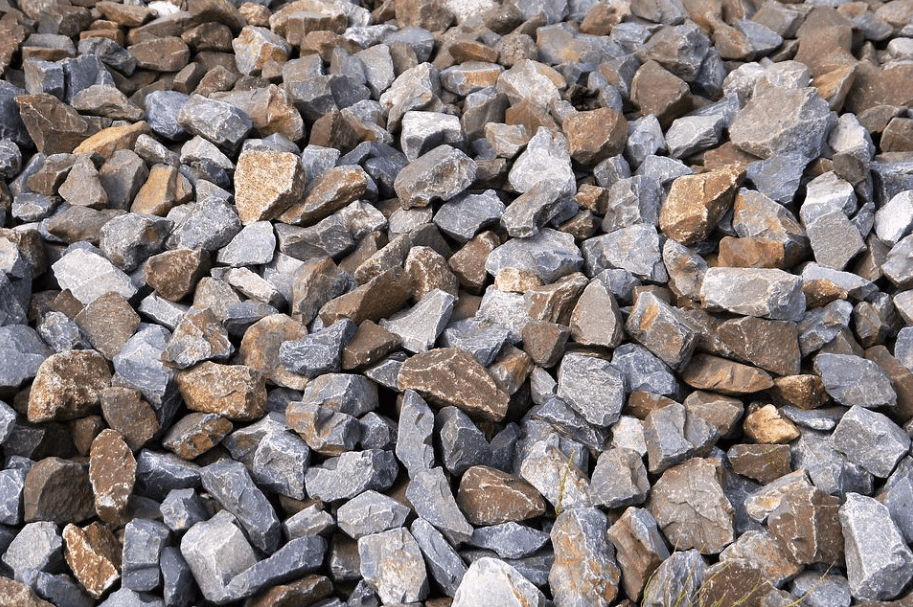
Crushed stone is a type of landscaping rock that is similar to landscaping gravel but is typically slightly larger with a more mixed color variety.
Because while landscaping gravel is typically offered in just one semi-uniform color, crushed stone is typically offered with a larger color mixture, ranging from brown and tan to gray and black.
Which makes crushed stone a much more visually interesting and colorful landscape rock compared to gravel.
Crushed Stone Cost
Depending on the size and color diversity of the rock, it will usually cost between $25 and $30 for a .4 to .5 cubic foot or 30 to 40-pound bag of crushed stone.
Pros
- Affordable
- Moderately Easy to Find
- Available in a Wide Variety of Colors and Color Mixtures
- Better Color Mixture Compared to Standard Gravel
Cons
- Rocks Have Sharp Edges that are Painful to Step On
- More Basic Look Compared to Other Landscape Rocks
6. Lava Rock
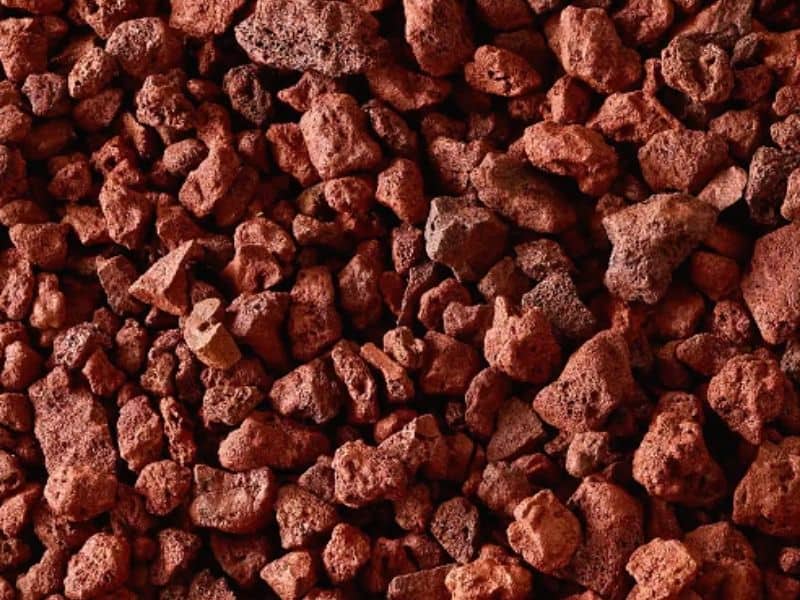
Volcanic rock more commonly known as lava rock is a type of rock that’s made from cooled lava that has solidified.
While not as popular as it once was, it remains a mainstay in landscaping beds and rock pathways today, thanks to its cheap cost and widespread availability.
Most commonly found in either red or black varieties, lava rock is a very coarse and porous stone, which makes it very rough on the skin but great for drainage.
Lava Rock Cost
Lava rock is very light, which means it’s often sold in lighter volumes with a 10 to 20-pound or .4 to .5 cubic foot bag usually costing between $5 and $25, depending on the size of the rock and its overall color.
Pros
- Very Porous Rock Great for Drainage
- Harder to Keep in Place Due to Rocks Light Weight
- Affordable
- Readily Available and Easy to Find
Cons
- Extremely Rough Rock that Can Be Painful to Walk On
- Has Fallen Out of Favor in Recent Years
7. Marble Chips
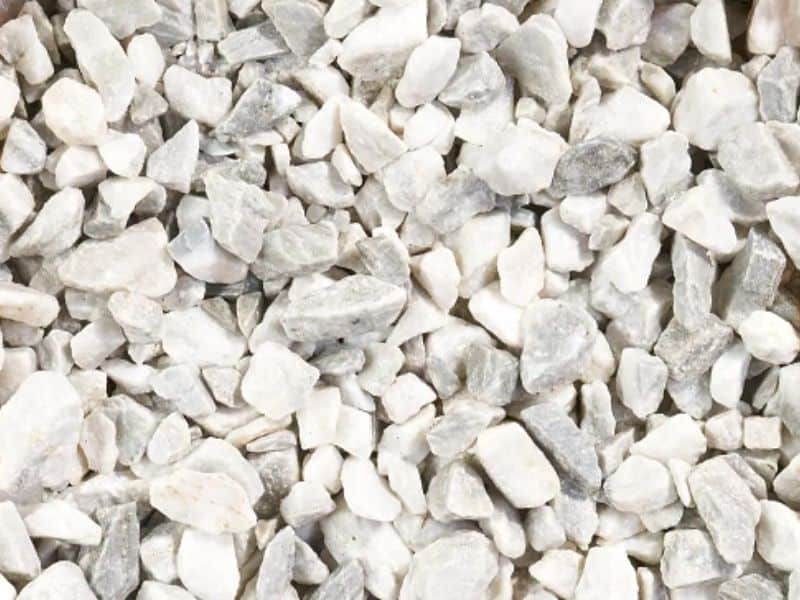
Marble chips are small pieces of marble that have been crushed or chipped to form small stones for landscaping rocks and other purposes.
They are available in a variety of colors but are most commonly found in either white, gray, or black.
Marble chips are a popular choice for landscaping because they’re relatively cheap and great for drainage.
It’s worth noting, however, if you plan to use the rock around plants, that marble chips are very high in pH, which will leach into the soil over time.
So you should avoid using marble chips around plants that prefer acidic soil.
Marble Chips Cost
Due to the high cost of marble, you might think that marble chips would be very expensive.
However, surprisingly marble chips are one of the most affordable landscaping rocks on the market, with a .4 to .5 cubic foot or 40 to 50-pound bag usually costing anywhere from $7 to $20, depending on the size of the chips and the overall color.
Pros
- Provides an Expensive Look at an Affordable Price
- One of the Cheapest Landscaping Rocks Available
Cons
- Rocks Have Sharp Edges that are Painful to Step On
- Fewer Color Options
- Can Sometimes Be Challenging to Find
- Rocks Have a High pH Content Which Can Be Harmful to Some Plants
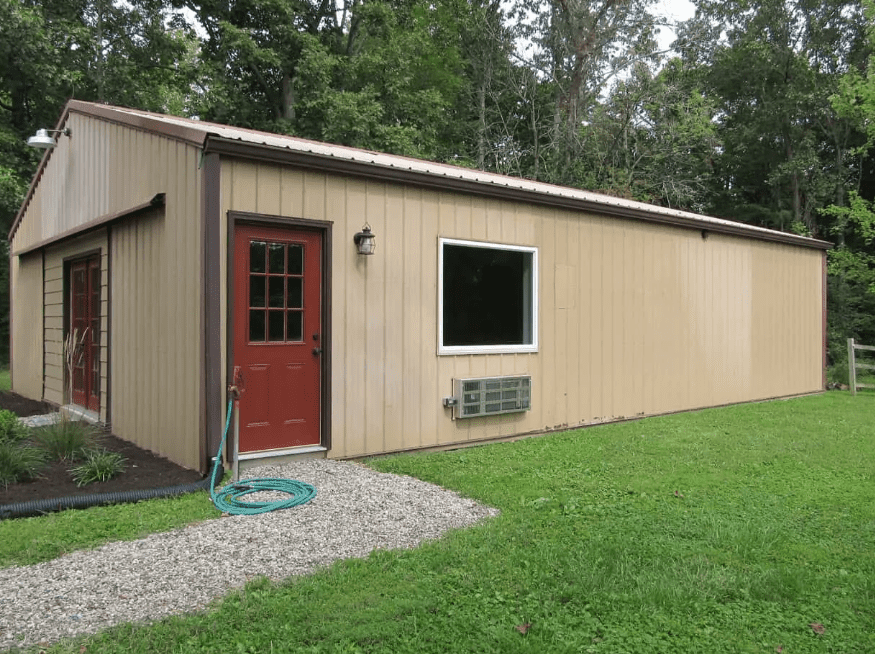
How Much Landscaping Rock Do You Need?
When buying landscaping rocks, you ideally want to buy enough to cover the entire area you’re working on the first time.
As this helps to avoid multiple trips back and forth to garden stores to purchase more rocks when you run out.
So let’s take a look at how to end up with just the right amount of rocks for your particular landscape project.
As a general rule of thumb, a 1/2 cubic foot of rock will cover approximately 10 square feet when spread 2 inches deep.
So for example, if you’re working on an area that’s 20 square feet, you would need 1 cubic foot of landscaping rock, which would be equivalent to 2 bags that are each 1/2 cubic foot.
It’s also important to note, however, that rock depth will affect how much you need.
For example, if you’re looking to cover an area with a 3-inch layer of rocks, you would need double the amount of rocks compared to if you were only spreading a 1-inch layer.
If you get confused though, not to worry, as many stores that sell landscaping rock will have calculators on their website that can help you determine exactly how much rock you need for your project.

What is the Cheapest Rock for Landscaping Wrap Up
When landscaping on a budget, one of the more important decisions you’ll make is choosing the right rock type for your landscaping project.
As each landscaping rock has its own set of pros and cons, both from a design standpoint as well as from a practical standpoint.
So in this article, we’ve covered some of the more popular and cheapest types of landscaping stones, including river rocks, landscaping gravel, pea gravel, and lava rocks.
To hopefully help you choose the right landscaping rock for your next rock project without breaking the bank.
No matter what type of landscaping rock you choose though, make sure to plan and measure your project first, before going to buy rock.
In order, to ensure you buy enough landscaping rock the first time to save yourself both time and hassle.
Additional Resources
To see the best landscape fabric for rock, check out our article “7 Best Landscape Fabrics for Rock and Gravel“.
To see the best shovels for digging and spreading rock, check out our article “10 Best Shovels for Digging (Ranked & Reviewed)“.
Recent Posts
Your bedroom is more than just a place to sleep; it's a personal sanctuary where you can unwind, relax, and recharge after a long day. Whether working with a small bedroom or a spacious suite,...
Are you ready to breathe new life into your living room? If so, look no further than modern living room colors, as they can transform your space from drab to fab. As the heart of the home, the...

